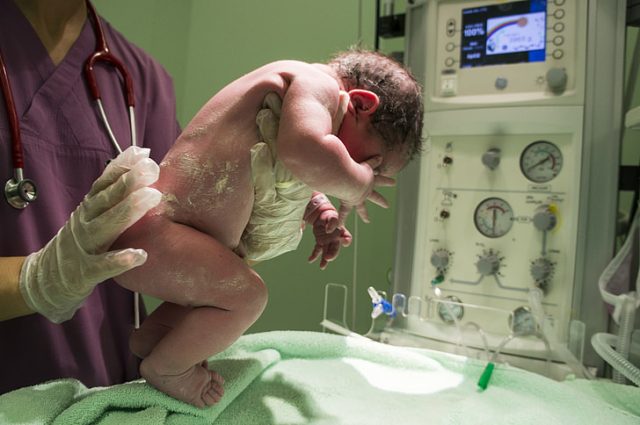
To the unprecedented demographic decline in recent years – in 2021 in the last 100 years the fewest children were born in Romania – we must unfortunately add the alarming figures on infant mortality. This is yet another chapter in which Romania “manages” to remain at the bottom of the European rankings, demonstrating that childbirth is still discriminatory. Poverty, lack of education and, above all, the acute need for investment in the public health system remain the main reasons why Romanians are still losing the battle against this painful phenomenon of infant mortality.
UNICEF estimated earlier this year that as many as 1.9 million babies were stillborn in 2021. According to the latest reports released in January by the UN Inter-Agency Group on Child Mortality Estimation (UN IGME), a further five million children died before their fifth birthday and another 2.1 million children and young people aged 5-24 lost their lives in 2021. Tragically, many of these deaths could have been prevented by ensuring equitable access to quality maternal, newborn, child, and adolescent health services, say UN experts.
“Far too many parents face the trauma of losing their child on a daily basis, sometimes even before their child takes the first breath,” says Vidhya Ganesh, Director of UNICEF’s Data Analysis, Planning and Monitoring Division, on the agency’s website.
“Such a great, preventable tragedy should never be seen as inevitable. Progress can be made through stronger political will and targeted investment to ensure equitable access to primary health care for every woman and child,” the source added.
Romania continues to record alarming infant mortality rates
UNICEF reports show some positive results and a decrease in the risk of death at all ages worldwide after 2000. The global under-five mortality rate has fallen by 50% since the turn of the century, while the mortality rate for older children and young people has fallen by 36%. Unfortunately, the smallest decline was in stillborn children – only a 35% drop in the rate. This decline is likely due to increased investment in developing primary health care systems for women, children and young people, UNICEF experts say. However, progress has slowed significantly since 2010 and 54 countries will fail to meet the Sustainable Development Goal target on under-five mortality, UNICEF experts add. It is well known that children’s chances of survival still vary widely depending on where they are born. Although it fares better than countries in Africa or Asia, Romania continues to record alarming figures for child mortality. According to European statistics (which are based on data provided by the Member States and, unfortunately, are currently only available for 2021) Romania ranks second in the EU in terms of infant mortality. Romania used to top this ranking, but has recently been overtaken by Bulgaria, according to Save the Children. Romania had an under-five mortality rate of 6.88 per 1,000 births in 2021 and an infant mortality rate of 5.63 per 1,000 births.

Statistics for the same year 2021 show that Bulgaria had an infant mortality rate of 5.6 per thousand live births, followed by Romania with a rate of 5.2 per thousand and Slovakia, where the infant mortality rate was 4.9 per thousand live births. At the other end of the scale, the countries with the lowest infant mortality rates for years are Sweden, Finland, and Slovenia with 1.8 per thousand live births.
Although COVID-19 did not directly cause an increase in child mortality – as children have a lower risk of dying from the disease than adults – the pandemic may have increased risks that could jeopardise children’s chances of survival in the future. In particular, the UN reports highlight concerns that disruption of vaccination campaigns, nutrition services and access to primary health care could jeopardise children’s health and well-being for many years to come. In addition, the pandemic has led to the largest continuous decline in immunisation in three decades, exposing the most vulnerable newborns and children to a higher risk of death from a range of preventable diseases.
One in ten newborns in Romania is born to underage mothers
One reason – the high number of births to teenage mothers. Statistics show that 1 in 10 newborns in Romania are born to mothers under 18. In fact, in Romania there are more than a quarter of mothers under 18 (30%) in the whole European Union and 45% of mothers under 15. We can say that Romania gives almost half the number of underage mothers in the European Union. At the same time, during pregnancy 40% of pregnant women or underage mothers do not access any other medical services except family medicine. The same study also shows that 80% of pregnant women or mothers under 18 have not used any contraceptive method. They claim that they had no information about the use of these contraceptive methods. The statistics also show that 75% of underage mothers have relatives or acquaintances who gave birth under the age of 18, 32% of whom say their mother was underage when she gave birth to them. Worryingly, the average age of the father of the children of underage mothers is 21.
According to representatives of the Save the Children organization, Romania has dropped one position in the European rankings thanks to the program to equip all maternity hospitals and neonatal intensive care units in the country with high-performance medical equipment. The organization has equipped 107 medical units (neonatology wards, neonatal intensive care units, pediatric wards and obstetrics and gynecology wards) in all the country’s counties with over 1,200 pieces of vital equipment, investing over 8,700,000 euros.
In Romania – childbirth remains discriminatory
The statistics cited by Save the Children reveal another painful truth: childbirth remains discriminatory. On the one hand, the infant mortality rate in Romania is almost double the European average – 3.4%. On the other hand, in one of Romania’s poorest counties, with many isolated communities, Tulcea for example, the rate is 11.1 per thousand, five times higher than in Bucharest.
“Birth in Romania remains discriminatory, as long as a premature baby born in a maternity hospital equipped with modern medical equipment survives to reach its first birthday, while a premature baby who has the misfortune to be born in a maternity hospital without medical equipment or with outdated and inefficient medical equipment has a much-reduced chance of life,” says Save the Children.
These figures are compounded by other worrying ones: 91% of neonatal wards are not equipped to care for all newborns.
Angela Galeța, director of the Vodafone Romania Foundation, which coordinates the Life for Newborns Fund project, recently drew attention to a significant cause contributing to the rising infant mortality rate: the lack of medical equipment in level 1 and 2 units in the country. Of the 224 neonatal units, compartments and wards in Romania, only 9% are level 3, i.e. those places equipped with all the necessary equipment to care for a newborn with problems or a premature newborn. These units are the only places where babies born under 1500 grams or under 32 weeks can be successfully cared for. In contrast, newborns are delivered in all the other facilities across the country.
“Level 1 units don’t even have an on-call line, they don’t have a doctor on call. Their role is to transfer the newborn immediately. Level 2 units have the right to care for newborns, but over 32 weeks, over 1500g. If they are born under, they have to transfer them to level 3 units. You can see what the ratio is: 9% versus 91%. Where to transfer them? Even if you find an open spot, it’s also important to establish it. And if you don’t have the equipment, you can’t do that, you can’t save it. The child, unfortunately, dies,” explained Angela Galeța.
According to available statistics, most deaths up to the age of 1 year in Romania occur after the first month of life. According to doctors, the main causes of infant mortality are respiratory diseases, followed by congenital anomalies and perinatal causes.



 Subscribe
Subscribe